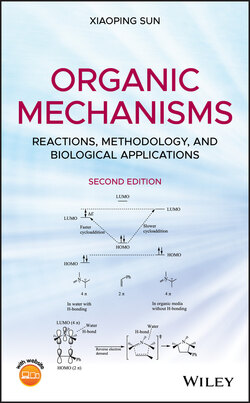Читать книгу Organic Mechanisms - Xiaoping Sun - Страница 10
Оглавление
FIRST EDITION PREFACE
In Summer 2010, I was contacted by Mr. Jonathan Rose, a senior editor of Wiley in Hoboken, New Jersey, for book review and possibly writing an organic mechanisms‐based textbook. We both agreed that a new book in this subject will meet the increasing needs of various upper‐level college students, instructors, and practicing chemists. I took up the challenge and came up with a detailed proposal regarding the contents, style, and features of the book. The proposal received favorable peer reviews and was approved by Wiley in December 2010. Then I started the writing process. It took me 18 months to finish writing the book. Meanwhile, I was teaching full‐time as well.
Since 1998, I have been on faculty at two higher educational institutions, West Virginia University Institute of Technology (1998–2001) and University of Charleston (2001–present). My current and previous research interests have much emphasis on reaction mechanisms. When I teach upper‐level organic chemistry and biochemistry courses, the lectures are also strongly mechanisms based. In the past dozen years or so, my teaching and research have been reinforcing each other. Now I wish to share my experiences with other colleagues, students, and different scientific workers in the chemical community by publishing this book.
The book consists of 10 chapters. It starts with reviews of various fundamental physicochemical principles (Chapter 1) which are essential for studying organic mechanisms. Then each of the following chapters is devoted to one major class of organic reactions. Thorough discussions on various reaction mechanisms are presented in the book in a very good detail, and a sophisticated and readily understandable manner. Special attention has been paid to mechanisms of different organic functionalization processes, such as methodology of aliphatic C—H bond activation and functionalization, charge‐transfer aromatic nitration and recently developed chemistry of aromatic compounds, and cycloaddition of alkenes to 1,3‐dipolar‐like molecules. Substantial efforts have been made in demonstrating direct applications of organic mechanisms in elucidating sophisticated biological and biochemical processes and designing organic synthesis. This can be seen throughout all the chapters and reflects a remarkable feature of the book. To facilitate teaching and learning, a Solutions Manual and PowerPoint slides of all the figures will be provided by the author and will be available for professors on a companion website for adopting instructors. I greatly appreciate all the constructive comments given by seven peer‐reviewers on the initial manuscript. The reviewers’ comments have helped the author tremendously in improving the book.
I would like to take this opportunity to dedicate my book to Dr. Jack Passmore, my former PhD supervisor, and to my organic chemistry and biochemistry students at University of Charleston. The book is also dedicated to my wife Cindy and my son Oliver.
Xiaoping Sun, PhD
Professor of ChemistryProfessor of Chemistry Charleston, West Virginia
